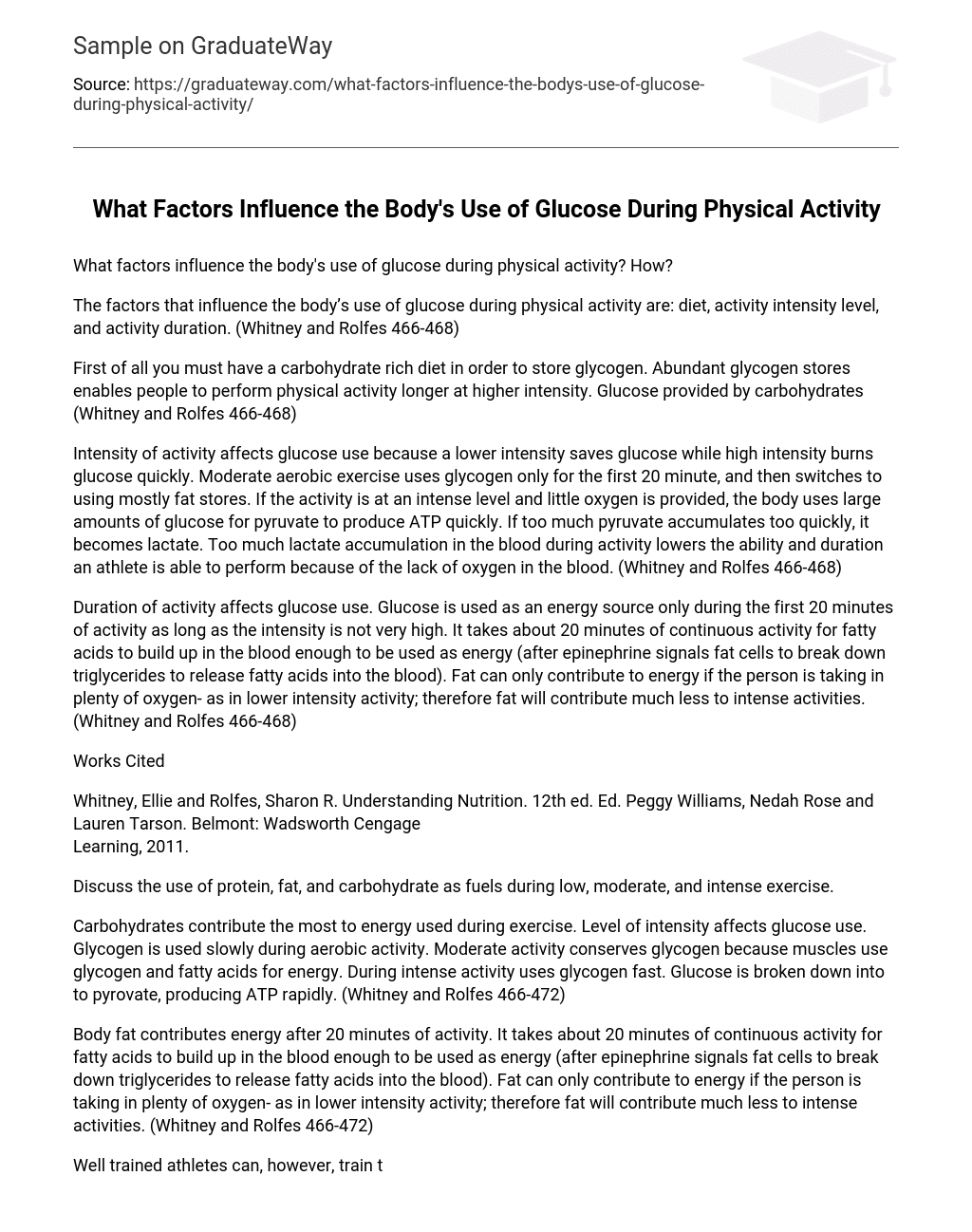What factors influence the body’s use of glucose during physical activity? How?
The factors that influence the body’s use of glucose during physical activity are: diet, activity intensity level, and activity duration. (Whitney and Rolfes 466-468)
First of all you must have a carbohydrate rich diet in order to store glycogen. Abundant glycogen stores enables people to perform physical activity longer at higher intensity. Glucose provided by carbohydrates (Whitney and Rolfes 466-468)
Intensity of activity affects glucose use because a lower intensity saves glucose while high intensity burns glucose quickly. Moderate aerobic exercise uses glycogen only for the first 20 minute, and then switches to using mostly fat stores. If the activity is at an intense level and little oxygen is provided, the body uses large amounts of glucose for pyruvate to produce ATP quickly. If too much pyruvate accumulates too quickly, it becomes lactate. Too much lactate accumulation in the blood during activity lowers the ability and duration an athlete is able to perform because of the lack of oxygen in the blood. (Whitney and Rolfes 466-468)
Duration of activity affects glucose use. Glucose is used as an energy source only during the first 20 minutes of activity as long as the intensity is not very high. It takes about 20 minutes of continuous activity for fatty acids to build up in the blood enough to be used as energy (after epinephrine signals fat cells to break down triglycerides to release fatty acids into the blood). Fat can only contribute to energy if the person is taking in plenty of oxygen- as in lower intensity activity; therefore fat will contribute much less to intense activities. (Whitney and Rolfes 466-468)
Works Cited
Whitney, Ellie and Rolfes, Sharon R. Understanding Nutrition. 12th ed. Ed. Peggy Williams, Nedah Rose and Lauren Tarson. Belmont: Wadsworth Cengage
Learning, 2011.
Discuss the use of protein, fat, and carbohydrate as fuels during low, moderate, and intense exercise.
Carbohydrates contribute the most to energy used during exercise. Level of intensity affects glucose use. Glycogen is used slowly during aerobic activity. Moderate activity conserves glycogen because muscles use glycogen and fatty acids for energy. During intense activity uses glycogen fast. Glucose is broken down into to pyrovate, producing ATP rapidly. (Whitney and Rolfes 466-472)
Body fat contributes energy after 20 minutes of activity. It takes about 20 minutes of continuous activity for fatty acids to build up in the blood enough to be used as energy (after epinephrine signals fat cells to break down triglycerides to release fatty acids into the blood). Fat can only contribute to energy if the person is taking in plenty of oxygen- as in lower intensity activity; therefore fat will contribute much less to intense activities. (Whitney and Rolfes 466-472)
Well trained athletes can, however, train their bodies in a way that will use fat as energy even during high intensity workouts. Training stimulates the, muscle cells to manufacture more and larger mitochondria that produce ATP. As respiratory strength increases they take in more oxygen more effectively. (Whitney and Rolfes 466-472)
Protein provides 10% of the body’s energy whether the body is inactive or very active. Amino acids, from protein, may end up providing energy during a very low carbohydrate diet because in the absence of glucose amino acids can be converted to glucose. During activity that last long enough and is intense enough to deplete glycogen stores, amino acids are also used as energy. Less protein is available for energy for people who strength train extensively. (Whitney and Rolfes 466-472)
Works Cited
Whitney, Ellie and Rolfes, Sharon R. Understanding Nutrition. 12th ed. Ed. Peggy Williams, Nedah Rose and Lauren Tarson. Belmont: Wadsworth Cengage Learning, 2011.





